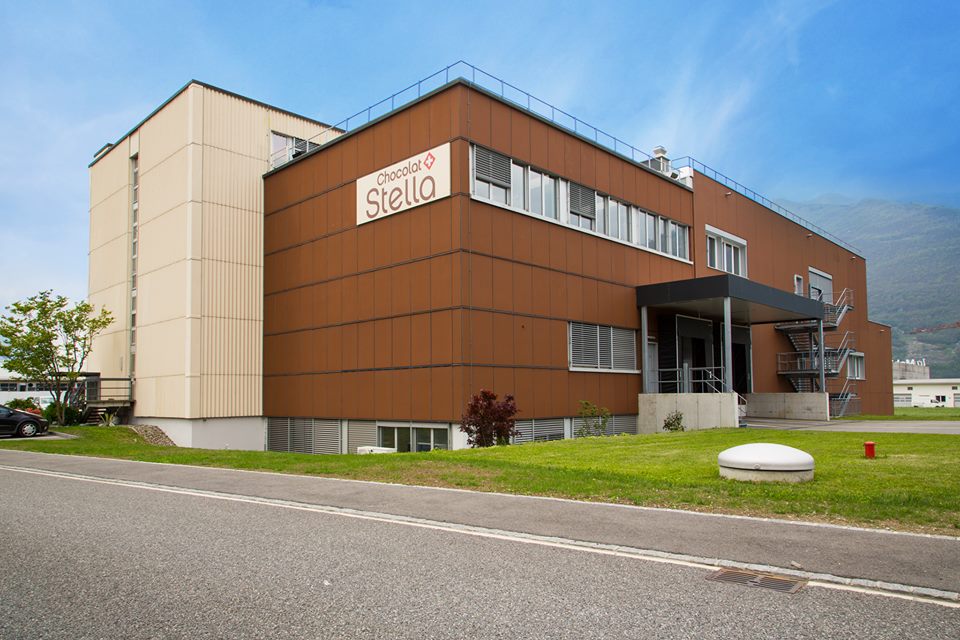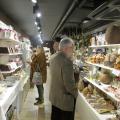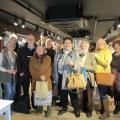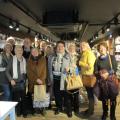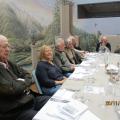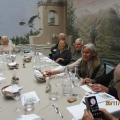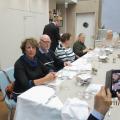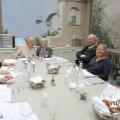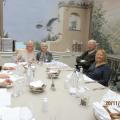Thirteen members signed up for this visit, where duly kitted out in the latest fashion, we were able to see the whole chocolate-making process and even enjoy sampling a variety of types of chocolate with different flavours.
The very successful visit to the Stella Chocolate Factory in Giubiasco was followed by lunch at the Hotel Tureta.
This agreeable restaurant, where we had a private room, was discovered by Beverly.
Penny Osti
A fuller report on this enjoyable day appears below the photos…
On the 20th of November as we drove north of Lugano to Giubiasco, the mountain tops were dusted with the first snows of winter, looking just like icing sugar, we were already having sweet thoughts in anticipation of our visit to a chocolate factory. Perfect timing with Christmas approaching, just like excited children we dressed in white coats, covered our shoes and heads in shower caps, looking everybit like 12 ‘oompa loompas’ ready for work in Roald Dahl’s’ ‘Charlie and the Chocolate Factory’. Calming down, we attentively followed our guide Antonio as he escorted us around an immaculate modern mechanized maze, explaining to us as we went, about the mysteries of chocolate production from pod and bean to a chocolate bar encased in shiny foil and cardboard wrapper with logo. The particular batch we observed was destined for Waitrose in Britain. Some 70% of production is for export to more than 50 countries around the world. Infact that is significant, because Switzerland is famous for it’s chocolate, but the ingredients that make it, come from all around the world and many countries have played a part in it’s evolutionary refining process.
Life for chocolate began as a drink some 500 BCE in the Mesoamerican area close to the equator in the Yucatan peninsula of todays Guatamala. A frothy bitter gritty fermented drink passed down from the Olmec civilization to the Maya people who named it Cocoa, the Toltecs, were then followed by the Aztecs. In Mexico they could not grow the cocoa tree which needed hot humid conditions found in the well drained nutrient rich soils of the rainforests. The Aztecs prized the beans so much they took them as tribute and used them as currency. They called the drink Xocolat meaning not alcoholic. The 16th Century saw the Spanish Conquistadors conquer the region and imported the precious beans to Europe. The Cocoa Tree was given the botanical name by Carl Linnaeus of „Theobroma Cacao“ from the Greek Theo = God and broma = food thus „food of the Gods“. It grows 15 metres high has glossy leaves and takes 7 years to mature before it produces many pods of different colour and sizes. It flowers all over the trunk and branches, so pods can sprout out anywhere. Today this crop is often grown on plantations 20 degrees north or south of the equator in South America, West Africa and South East Asia. Our Stella pride themselves upon their ethically sourced organic cocoa beans. They help the small farmer importing from 20 countires including Ecuador, Madagascar, Trinidad, Costa Rica, India and Peru. They work directly with cooperatives through Fairtrade cultivation when selecting their raw materials. The beans once extracted from the pod, need to ferment and then be dried/roasted and shelled, keeping 8% of their moisture, and guarding against mould when transported abroad.
Chocolate has always been a luxury, a high status superfood possessed with curative powers and this was no exception in Europe. The Spanish, Italian and French Courts drank their chocolate sweetened with sugar and flavoured with spices like cinnamon or vanilla for health and pleasure. The fashion caught on in London, a gentlemans club in St James of Mayfair, started life as White’s Chocolate House. The French were the first to transform it into a bar of chocolate but it could still be gritty and oily. With the industrial revolution, machinery improved the grinding process. In Britain two Quaker’s Fry and Cadbury competed to perfect their drinking chocolate. The Dutch invented a press to squeeze out the oil (cocoa butter) from the cocoa beans, which were then ground into a fine cocoa powder. Fry mixed the cocoa powder with sugar and melted cocoa butter allowing it to cool in a mould creating a bar of chocolate. But it was the Swiss that made a leap forward in 1879 Mr Lindt created the process of conching and Mr Nestle added more milk. So it is the machinery some of it invented specifically for the refining of chocolate which is in essence still used today. So as we moved into noisy well lit rooms full of massive vats Antonio shouted above the grinding, mixing and conching machine activity and we climbed wee ladders and peered into large vats at chocolate masses in various stages towards liquid while no more than a handful of men checked digital thermometers controlling quantities of ingredients going into one container and up conveyor belts or tubes onto the next stage. Afterwards, we understood firstly the beans are GROUND into a paste melting the cocoa butter and releasing cocoa liquor. This paste is further PRESSED until the cocoa butter is out, which then goes to be filtered for adding later to make the chocolate silky and shiny. Other weighed ingredients are MIXED in with the paste like sugar,milk, flavours and filtered cocoa butter which leaves a grainy sand like paste. The smoothing of this paste is called CONCHING. The paste is heated and mixed, kneaded and worked until velvety smooth this can take 72 hours. The final stage is TEMPERING where the liquid chocolate is heated to 50 degrees and then cooled to 30 degrees to allow the cocoa butter to form crystals, it thickens it, ready for it’s moulds this process keeps the chocolate shiny as it solidifies.
We came to the top floor, the packing room which was operated by half a dozen ladies Stella employs some 50 persons only at this factory. After a tasting session we descended to the poorly lit store rooms and learnt more about where and what ingredients were sourced, interestingly they use Coconut blossom sugar. Their imaginative, conscientious and innovative approach to making chocolate, their awareness of the social and environmental impact their business has today beyond their factory walls was a selling point to me as a potential consumer. Not to mention their choice of chocolate types, for Diabetics, Lactose free, Organic, Single-Origin, 70% cocoa, also normal chocolate and alot of new flavours, so I admit to picking up a few gifts especially the dark chocolate with pomogranate or baobab fruit or ginger and lemon. Stella a family run business since 1928 are keeping apace if not ahead with their customers lifestyle choices and emotional needs. Sugar gives a body quick energy combined with fat it creates a food we crave. The scientists have now proved dark chocolate really does boost brain function and is a happy mood enhancer releasing endorphins. Just to mention a few chemicals, like theobromine which acts like caffeine stimulating the brain, is a mild aphrodisiac. Magnesium relieves stress, tryptophan boosts production of serotonin the neurotransmitter of happiness and positive mood. Finally, phenylethylamine which creates the sensation of being in love. So it would appear there might be something in the old television advert after all, when we were told « All because the Lady Loves Milk Tray ». We adjourned to the nucleo of Giubiasco to the light airy restaurant of La Tureta, where we lunched on a delicious cream of spinich soup followed by a pumpkin risotto and branzino alla mediterranea with vegetables of the season, probably the really healthy option if I am honest. I cannot remember dessert, it might have been a healthy chocolate mousse!
Jenny Pappert Hall

